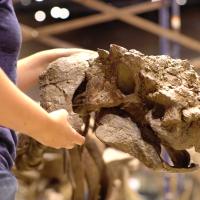Ten years ago, the journey to discover the Akainacephalas Johnsoni, the newest dinosaur to be named from Utah, began. The dinosaur’s skeleton was uncovered in a dig site at the Grand Staircase Escalante Monument. There were a plethora of other skeletons found alongside the Akainacephalas, including the Gryposaurus (duck-billed dinosaur) and the Arvinachelys (turtle-like dinosaur).
“It takes thousands of hours in fossil preparation lab to fully extract bones from the rock,” said Paleontology Curator Randall Irmis. “It’s only once the bones start to emerge that we can see the detail.”
It took countless hours just to dig up the skull of Akainacephalus. Volunteer Randy Johnson is accredited for the bulk of uncovering the skull, and for this reason the dinosaur is partially named after him.
Once all of the bones were out of the rock, it was soon confirmed that Akainacephalus was a dinosaur that has never been seen before. University of Utah graduate student Jelle Wiersma took on researching this new dinosaur as a part of his master’s thesis. It took him several years to publish his findings. His results helped to demonstrate how a variety of dinosaurs evolved and migrated around the world. Wiersma was able to connect two continents by suggesting that, “at least two immigration events took place during Late Cretaceous times when lowered sea levels exposed the Beringian land bridge, connecting Asia with western North America. Ankylosaurid dinosaurs, among many other groups of animals, eventually crossed this land bridge, emigrating from Asia into western North America, resulting into two different types of Late Cretaceous Ankylosaurid dinosaurs: ones that evolved flatter skull armor like Ankylosaurus and Euoplocephalus, and ones possessing very spiky skull armor such as Akainacephalus and Nodocephalosaurus.”
From the initial dig, the end goal is to put the skeleton on display in the Natural History Museum of Utah. A lot more research can be done on the dinosaur now that it’s been completely excavated. Irmis explained, “Researchers from all over the world will come to see [the dinosaur], and study it. We did the basic anatomical description, naming it, and tying what it is related to. Looking at the shape of the brain, we can CTC test scan the skull, and that can show us the shape of the brain. We can look at how the muscles attached and how the animal moved. It is common for fossils that were discovered and named a while ago to still be researched more. It is important that we preserve this fossil so that future generations of scientists and visitors can see it.”
The field team is currently continuing to work excavate fossils at the Grand Staircase Escalante Monument.
“There’s such a bounty of new things. There’s between 10-12 species we’ve excavated that we are still doing work on. This will be going on for a long time,” Irmis said. For now, Akainacephalas is Utah’s newest marvel to study, but there are still many more mysterious dinosaurs waiting to be discovered.


